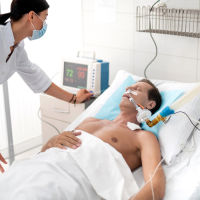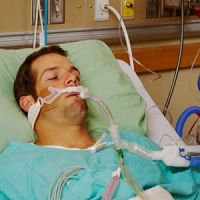Over 1 million people patients throughout the world receive mechanical ventilation for acute respiratory failure. The management of these critically ill patients and liberating them from invasive ventilation is one of the most important decisions clinicians have to make. Liberation from ventilation is also a major dilemma for clinicians because any error could result in significant harm to the patient. Premature or failed attempts at extubation could increase the rate of ventilator-associated pneumonia, mortality, and adverse outcomes. At the same time, delaying extubation could increase the patient's risk of being oversedated and developing delirium or ventilator-associated events. What should a clinician do?
The standard of care when managing critically ill patients who are on mechanical ventilation is to screen them daily so that patients who are ready to undergo a spontaneous breathing trial (SBT) can be identified. Daily screening can also help assess extubation failure risk factors such as weak cough, heavy secretion, a low level of consciousness, etc. The SBT is the standard assessment of ventilator liberation readiness, and studies have shown that using daily SBTs can hasten successful liberation. Findings have also shown that a respiratory therapy-driven SBT protocol provides better results than a physician-directed approach.
Different techniques can be used when conducting an SBT. If a T-piece SBT is being used, the patient will receive supplemental oxygen without ventilatory assistance. If the pressure support ventilation (PSV) technique is being used, the patient will be given a small amount of positive pressure to assist inspiration.
In a recent clinical trial, the largest of its kind, different SBT techniques were compared. 1153 mechanically ventilated patients were included in the study, and 2 different SBT techniques were used. One was a 2-hour T-piece SBT, and the other was a 30 minute PVS SBT. In both patient groups, those who successfully completed their SBT were extubated.
Findings of the study showed that participants in the 30-minute PSV SBT group were more likely to be extubated compared to patients in the 2-hour T-piece SBT group. Successful extubation occurred in 82.3% of patients in the PSV group and in 74% of patients in the T-piece group. Also, patients in the PVS-SBT group did not experience a high reintubation rate in the 72 hours after extubation, and they were also less likely to die in the hospital or during 90 days after randomisation. These results demonstrate that most patients can be tested for 30 minutes using PSV.
These findings raise an important question: why do clinicians continue to rely on 120-minute SBTs even though 30-minute SBTs provide the same results (if not better). There are also other questions that should be considered. When should SBTs start during a patient's recovery from acute respiratory failure? What strategies can be used to effectively recognise which patients are ready for extubation? Also, should a 30-minute PSV SBT be used regardless of a patient’s characteristics or circumstances or is there a specific criterion that needs to be followed? Are long-term outcomes affected based on the SBT technique that is used? If yes, how?
The point is that liberation from mechanical ventilation remains a challenge in the ICU. There is no doubt that there is a knowledge gap in this area, and much work needs to be done to improve the outcomes of mechanically ventilated ICU patients.
Source: JAMA
Image Credit: iStock
References:
Girard TD et al. (2019) Revisiting, Reframing, and Casting a New Light on Liberation From Mechanical Ventilation. JAMA, 321(22):2167-2169.
Latest Articles
mechanical ventilation, extubation, mechanical ventilators, SBT, spontaneous breathing trial
In a recent clinical trial, the largest of its kind, different SBT techniques were compared.



























